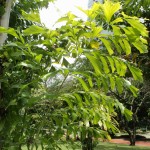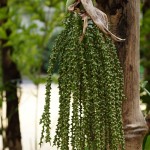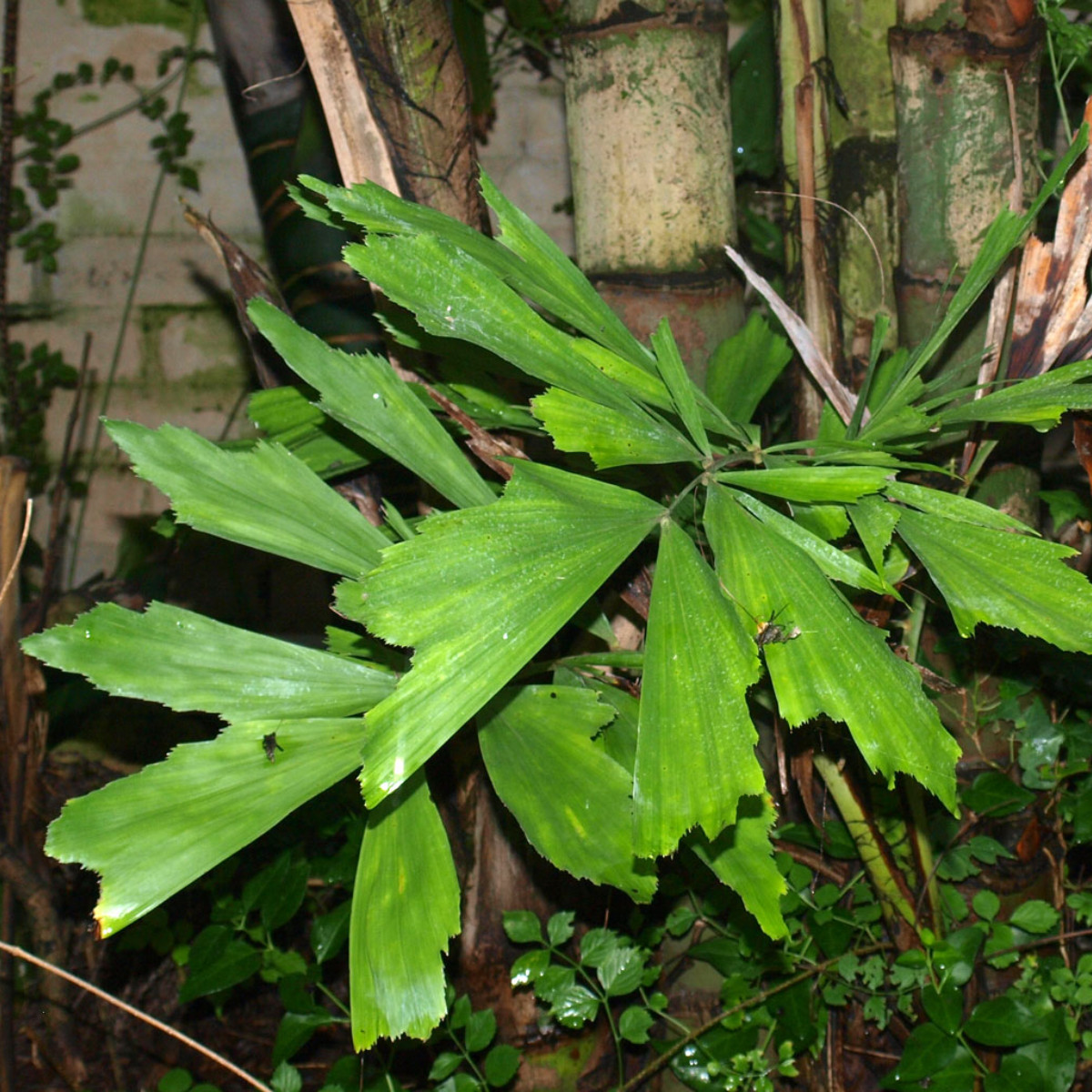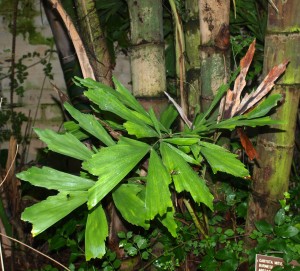Synonyms: Caryota furfuracea Blume ex Mart.
Caryota griffithii Becc.
Caryota griffithii var. selebica Becc.
Caryota javanica Zipp. ex Miq.
Caryota nana Linden
Caryota propinqua Blume ex Mart.
Caryota sobolifera Wall. ex Mart.
Caryota sobolifera Wall.
Caryota speciosa Linden
Drymophloeus zippellii Hassk.
Thuessinkia speciosa Korth.
Family: Arecaceae
Distribution and Habitat:Caryota mitis is native to southeast Asia where it grows as an understory plant in tropical rain forests.
Description:Stems clustered, leaves bipinnate, leaflets or pinnules fish-tailed shaped hence the common name. Caryota mitis is an upright plant with a semi-vase shaped growth habit. Indoors usually not over 2.5m (8 feet) in height and 1.5m (5 feet) in width. Caryota mitis may carry six to eight deeply arching, bipinnate fronds on 30-60cm (12-24 inch) long leaf-stalk and these form a sort of crown to the plant. Several smaller fronds are also generally clustered around the base of the main stem. The largest fronds may be as large as 90cm (35 inch) wide with each light green secondary leaflet about 15cm (6 inch) long and 12cm (5 inch) wide; the leaflets grow close together in clusters of 20 to 30.
Houseplant care: Caryota mitis is slow growing palm - no more than few centimeters (one inch) a year for a stem that may reach an ultimate height indoors of 20.5m(8 feet) or more.
Because it is shallow rooted,Caryota mitis should be planted in an area protected from wind. This palm is perfect for understory planting in woodland areas.
Light: Caryota mitis palm grow best in full sunlight filtered through a translucent blind or curtain.
Temperature: Caryota mitis likes warmth and cannot tolerate temperatures below 13C (55F). In very warm rooms, however, increase humidity by standing the pot on a tray of moist pebbles or damp peat moss.
Water: Caryota mitis should be watered plentifully, as often as necessary to keep the soil thoroughly moist, but never allow pot to stand in water.
Potted Caryota mitis are not likely to have well defined periods of growth and rest, but growth may be slow during the autumn and winter periods. In period when plants appear to be growing slower than usual it is advisable to allow the top 1cm (0.3 inch) of the potting mixture to dry out completely before waterings.
Fertilising: Apply liquid fertilizer once a month from early spring to mid-autumn only.
Potting and repotting: Use a soil based potting mixture. Caryota mitis like to have their roots constricted and should therefore be grown in pots that seems too small for them. Move these palms into pots one size larger only once every two or three years at the time they are just breaking into fresh growth.
Put clay pot fragments in bottom of the pot for drainage and pack the potting mixture firmly around the roots taking care, however, do not break any of the ticker roots in the process. Once the plant is in a pot of maximum convenient size, give it an annual top dressing.
Propagation: It is possible to propagate Caryota mitis from seed sown in spring at a temperature at least 24C (75F). Seeds take 4-6 months to germinate. Flowers and fruits are never produced when Caryota mitis is grown indoors.
Caryota mitis can be propagated from suckers (basal growth) or offsets. Detach the growth when it is 20-30cm (8-12 inch) tall, retaining some of the attached root and plant it in a 8-10cm (3-4 inch) pot of barely moistened soil-based potting mixture. Stand the top (uncovered) in warm place where it gets filtered light and water only enough to make the potting mixture barely moist, allowing the top 1cm (0.3 inch) of the mixture to dry out between waterings.
New growth will indicate that rooting has occurred. thereafter, the cultivation needs of the yang plant are the same of a mature Caryota mitis.
Use: The Caryota mitis palm can be used in shrub borders and outdoor container plantings. It tolerates heavy shade and is often used in interior plantings in commercial buildings. It does well in indoor containers.
The leaves can also be used as floral decorations.
Toxicity: Avoid contact with the red fruit produced by Caryota mitis palm. It contains oxalic acid which is toxic when ingested, and contact with skin may result in severe chemical burns.
Fruit, leaves and stems contain various alkaloids. Pulp of mature fruit contains calcium oxalate crystals. Fibrous hairs of the leaf stalk produce skin irritation.
Problems: Brown leaflet tips and attacks of spider mites usually indicate that the air is too dry. There is no need to worry, however, if an occasional frond turns entirely yellow and than brown before dropping off. It is entirelly natural for one old frond of a Caryota mitis to die off every years or so.
Spider mites are the most common pest problem of the Caryota mitis.
Treatment: Toughly hose them off or Spray the plant with an insecticidal spray.
Pseudomonas disease: brown and wet lesions that usually run parallel to the leaf vein.
Treatment: Remove the infected leaves to stop the disease from spreading.
Interesting facts: Caryota species differ from other palms in that their fronds are bipinnate - each primary leaflet (pinna) is divided into secondary ones (pinnules). The grey-green leaf-stalks vary in length according to species, but the stalks of all species carry these bipinnate fronds, which are divided in herringbone fashion into sections that are again subdivided into many wedge-shaped; each secondary leaflet is folded into a V-shape with ragged edge like a tattered fishtail.
Caryota mitis palms are interesting in that they are monocarpic. After flowering, the plant dies,fruiting from the top down. But Caryota mitisare also suckering so the entire plant does not die, just the stem that flowered.Other trunks of suckering Caryota mitis would survive.These facts makes Caryota mitis one of the shorter lived palms, sometimes living out their entire natural life in ten to twenty years.
Various parts of the plant have been used in many different ways by natives of countries where this plant grows in the wild. The kernels of the fruit and the terminal bud are edible but only after proper processing. The inflorescence can yield saps which can be consumed fresh as nira or fermented to produce toddy, then distilled into potent arak. A process of refining the sap can produce sugar called jiggery which contains 2.3% protein and significant amount of vitamins. The core of the growing tip can be cooked and eaten. Starch (sago) can be extracted from the pith which forms part of the diet of the aboriginal dwellers of the rainforest.
Medicinally, the fibers are used to treat poisonous animal bites and insect stings.
CHARACTERISTICS:
Foliage green
Shape bushy
PROPER CARE:
Watering in rest period moderately
Watering in active growth period plentifully
Light bright filtered
Temperature in rest period min 13C max 21C (55-70F)
Temperature in active growth period min 16C max 24C (61-75F)
Humidity high
Hardiness Zone: 9b-10





